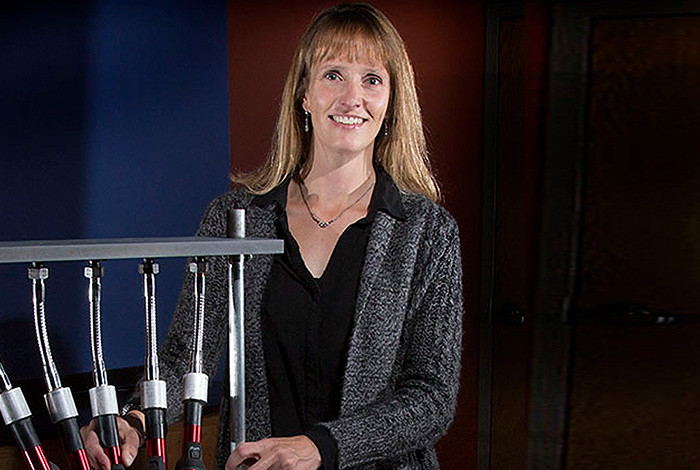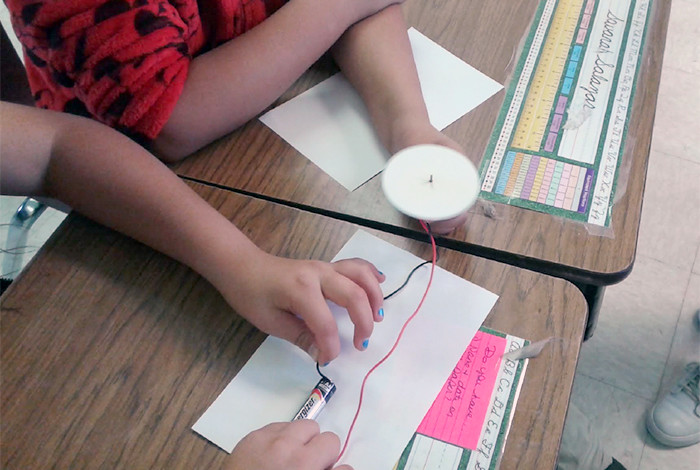Astrophysicist connects with local kids

As a Scientist Ambassador, Lloyd-Ronning demonstrates how beams from flashlights with color filters combine to make white light.
Laboratory astrophysicist Nicole Lloyd-Ronning shares her love for science with the greater community. Some of the many projects she is involved with as part of the science, technology, engineering, and math (STEM) outreach efforts of the Lab’s Center of Theoretical Astrophysics include:
- leading a UNM-LA community education class on modern astrophysics for students ranging from high-school age to retirees
- running a “Physics is Fun” series of hands-on activities with elementary school classes in Española, Santa Clara Pueblo, and Los Alamos
- assisting with an Española middle school astrophysics class with hands-on activities and short presentations on cutting-edge research topics
- helping develop the hands-on lab component for an upcoming astronomy class elective at Los Alamos Middle School
- facilitating a week-long summer astrophysics teen college at UNM-LA for grades 7–10
Lloyd-Ronning is also a Bradbury Science Museum’s Scientist Ambassador, of which she says, “Being an ambassador is a really excellent way for Los Alamos scientists to share their research and connect with the general public.”
The Community Partnerships Office recently asked Lloyd-Ronning a few questions about her volunteerism to inspire others to consider giving their time and sharing their expertise with the community.

Kids figure out on their own how to turn a multicolored circle into one single color by spinning it, a simple analogy to help understand why light appears white when it is actually made of many colors.
CPO: Why do you support STEM outreach?
NL-R: Most STEM fields (especially astrophysics!) are extremely interesting, and it is just awesome to explore these topics with students. I also think it’s important to remind people of the role STEM fields play in all of our lives and in our futures—from technological advances, like computers, the internet, and smartphones, that increase quality of life, to the role STEM plays in solving global problems of disease, hunger, climate change, and more. Ultimately, for me it is about conveying the pure joy of learning a little bit about our universe.
CPO: Would you encourage others to participate?
NL-R: Innovative solutions to hard problems require a range of perspectives and viewpoints. These innovations emerge more readily when people from all backgrounds contribute to STEM fields, and personal interactions between students and scientists can go a long way toward opening science to a more diverse group of people—especially when a diverse group of scientists participate.
CPO: What do volunteers and kids gain from community outreach?
NL-R: One of the biggest advantages of scientists participating in STEM outreach is that positive, fun, scientist-to-student interactions can leave future generations with a more accurate impression of how science is done. Hopefully, this also facilitates youth to look openly and critically at future scientific endeavors.
CPO: Describe the impact of your work on students.
NL-R: Kids respond in different ways to the experiments we do in class—some are immediately into it with lots of ideas and questions from the start, while others take some time realizing there is no right or wrong. They start to realize it’s about trying things and learning from those trials and inevitable mistakes. The longer I’m with a single class, the more I see some of the quieter kids come out of their shells, which is wonderful to witness. It helps when we have really cool materials to work with, and they all seem to love magnets, motors, bouncy balls, and dry ice.

Middle school kids make secret-coded messages with one color crayon and then color over it with a different color. The message is revealed when viewed through some color filters and completely disappears through other filters. The activity demonstrates how differently things look when examined with just one color or energy of light.






